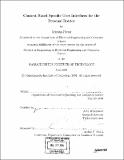Context based specific user interfaces for the personal router
Author(s)
Foster, Kristina, 1981-
DownloadFull printable version (3.021Mb)
Other Contributors
Massachusetts Institute of Technology. Dept. of Electrical Engineering and Computer Science.
Advisor
John Wroclawski.
Terms of use
Metadata
Show full item recordAbstract
For this thesis, I am concerned with the User Interface (UI) design of the Personal Router (PR), a device that dynamically selects wireless services in an open market on behalf of a mobile user [3]. The Personal Router chooses from a set of locally available services based on their Quality of Service (QoS) attributes as well as the user's preferences for these attributes, which the PR learns by interacting with the user [10]. To ensure accurate learning it is necessary that the PR/user interaction is both intuitive and non-obtrusive to the user and informative to the PR, often two conflict goals. Meeting both goals simultaneously requires a Context Based Specific User Interface that adjusts how it interacts with the user based on his context, where context is loosely defined as interaction constraints imposed by the user's environment, activity or situation. The context specific UI allows the PR to acquire the most informative user information for accurate learning while being as intuitive and non-obtrusive as possible. In this thesis, I present the design of the Context Based Specific UI as well as three different implemented UIs that vary in the amount of detail they allow the user to express. Although the less detailed UIs require less interaction from the user, the resulting learned information is not as accurate of the user's feelings and is based on assumptions of the user's behavior. The more detailed UIs have the opposite advantage and disadvantage. Finally, I present a method of combining the three Uls such that the user can select the one that best matches his current context.
Description
Thesis (M. Eng.)--Massachusetts Institute of Technology, Dept. of Electrical Engineering and Computer Science, 2004. Includes bibliographical references (p. 59-60).
Date issued
2004Department
Massachusetts Institute of Technology. Department of Electrical Engineering and Computer SciencePublisher
Massachusetts Institute of Technology
Keywords
Electrical Engineering and Computer Science.